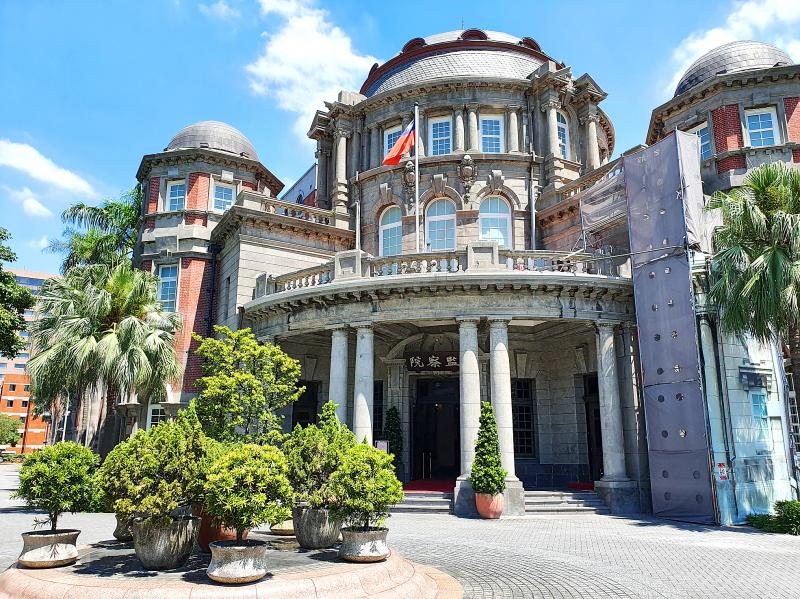The Control Yuan yesterday published data on political party finances from last year, showing more income and expenditure for the Democratic Progressive Party (DPP) than for the Chinese Nationalist Party (KMT).
According to the figures published on the Control Yuan’s public database of political contributions in Taipei, the DPP netted NT$187.46 million (US$6.43 million) and spent NT$190.61 million, while the KMT earned NT$116.61 million and spent NT$117.13 million.
The New Power Party (NPP) made NT$28.82 million and had assets totaling NT$6.2 million, more than triple the NT$1.74 million it had in 2018, the data showed.

Photo: Hsieh Chun-lin, Taipei Times
In its first filing, the Taiwan People’s Party (TPP) netted NT$81.47 million and spent NT$38.9 million, the data showed.
Of the DPP’s earnings, NT$99.69 million came from personal donations, NT$85.27 million from for-profit businesses, NT$714,000 from political donations, NT$1.78 million from anonymous donations and NT$9,067 from other sources.
The party’s account stood at NT$26.94 million, up slightly from NT$20.47 million in 2018.
The DPP spent NT$41.13 million on personnel, NT$34.05 million on business expenses, NT$90,300 on public relations, NT$78.54 million on elections, NT$30.8 million on political campaigns, NT$596,557 on miscellaneous expenditures and NT$5.42 million on donation reimbursements, the data showed.
Meanwhile, NT$63.71 million of the KMT’s income came from personal donations, NT$51.6 million from for-profit businesses, NT$845,000 from political donations, NT$457,961 from anonymous donations and NT$4,086 from other sources, the data showed.
Its account stood at NT$12.64 million, up from NT$3.54 million in 2018.
The KMT’s expenses included NT$47.61 million on personnel, NT$26.11 million on business expenses, NT$256,487 on public relations, NT$16.53 million on elections, NT$20.23 million on political campaigns, NT$732,933 on miscellaneous expenditures and NT$4.79 million on donation reimbursements, while NT$880,000 was paid into the treasury.
In its first year, the TPP netted NT$64.36 million from personal donations, NT$16.5 million from for-profit businesses, NT$300,000 from political donations, NT$312,643 from anonymous donations and NT$403 from other sources, while its total assets stood at NT$52.13 million, the database showed.
As for expenditures, the TPP spent NT$2.38 million on personnel, NT$4.69 million on business expenses, NT$79,915 on public relations, NT$19.73 million on elections, NT$8.5 million on political campaigns, NT$396,413 on miscellaneous expenses and NT$2.45 million on donation reimbursements, while NT$700,000 was paid into the treasury.
Of the NPP’s NT$28.82 million in earnings, NT$64.36 million came from personal donations, NT$597,550 from for-profit businesses, NT$920,000 from political donations, NT$3.53 million from anonymous donations and NT$2.08 million from other sources, the data showed.
The NPP spent NT$15,000 on personnel, NT$8.34 million on business expenses, NT$8.45 million on elections, NT$1.07 million on campaign contributions, NT$200,000 on miscellaneous expenses, NT$270,000 on donation reimbursements and nothing on public relations, while NT$18,748 was paid to the treasury.
The NPP had NT$3.35 million in the bank, in addition to NT$2.1 million in cash, NT$390,000 in bills receivable and NT$355,840 in nonexpendable property for assets totaling NT$6.2 million, its filings showed.
Meanwhile, the New Party made NT$6.68 million in income consisting primarily of NT$4.7 million in personal donations and NT$1.69 million in for-profit business donations, with expenditure totaling NT$6.57 million mainly due to NT$5.47 million in election costs and about NT$950,000 in public relations costs, the data showed.
The party’s account stood at NT$142,854, comparable to the NT$129,972 it had in 2018.

SHIPS, TRAINS AND AUTOMOBILES: The ministry has announced changes to varied transportation industries taking effect soon, with a number of effects for passengers Beginning next month, the post office is canceling signature upon delivery and written inquiry services for international registered small packets in accordance with the new policy of the Universal Postal Union, the Ministry of Transportation and Communications said yesterday. The new policy does not apply to packets that are to be delivered to China, the ministry said. Senders of international registered small packets would receive a NT$10 rebate on postage if the packets are sent from Jan. 1 to March 31, it added. The ministry said that three other policies are also scheduled to take effect next month. International cruise ship operators

NUMBERS IMBALANCE: More than 4 million Taiwanese have visited China this year, while only about half a million Chinese have visited here Beijing has yet to respond to Taiwan’s requests for negotiation over matters related to the recovery of cross-strait tourism, the Tourism Administration said yesterday. Taiwan’s tourism authority issued the statement after Chinese-language daily the China Times reported yesterday that the government’s policy of banning group tours to China does not stop Taiwanese from visiting the country. As of October, more than 4.2 million had traveled to China this year, exceeding last year. Beijing estimated the number of Taiwanese tourists in China could reach 4.5 million this year. By contrast, only 500,000 Chinese tourists are expected in Taiwan, the report said. The report

The Forestry and Nature Conservation Agency yesterday launched a gift box to market honey “certified by a Formosan black bear” in appreciation of a beekeeper’s amicable interaction with a honey-thieving bear. Beekeeper Chih Ming-chen (池明鎮) in January inspected his bee farm in Hualien County’s Jhuosi Township (卓溪) and found that more than 20 beehives had been destroyed and many hives were eaten, with bear droppings and paw prints near the destroyed hives, the agency said. Chih returned to the farm to move the remaining beehives away that evening when he encountered a Formosan black bear only 20m away, the agency said. The bear

Chinese embassy staffers attempted to interrupt an award ceremony of an international tea competition in France when the organizer introduced Taiwan and displayed the Republic of China flag, a Taiwanese tea farmer said in an interview published today. Hsieh Chung-lin (謝忠霖), chief executive of Juxin Tea Factory from Taichung's Lishan (梨山) area, on Dec. 2 attended the Teas of the World International Contest held at the Peruvian embassy in Paris. Hsieh was awarded a special prize for his Huagang Snow Source Tea by the nonprofit Agency for the Valorization of Agricultural Products (AVPA). During the ceremony, two Chinese embassy staffers in attendance